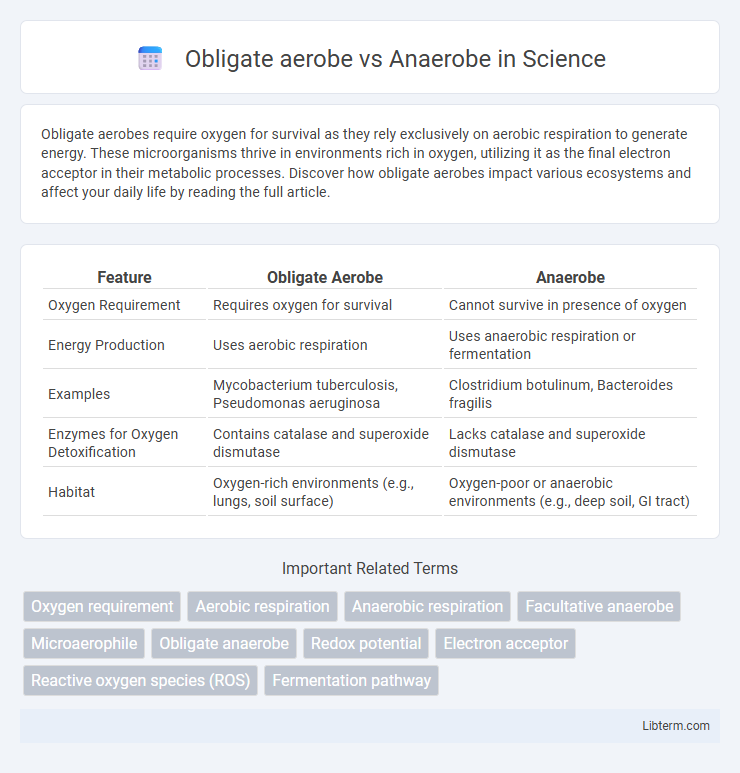Obligate aerobes require oxygen for survival as they rely exclusively on aerobic respiration to generate energy. These microorganisms thrive in environments rich in oxygen, utilizing it as the final electron acceptor in their metabolic processes. Discover how obligate aerobes impact various ecosystems and affect your daily life by reading the full article.
Table of Comparison
| Feature | Obligate Aerobe | Anaerobe |
|---|---|---|
| Oxygen Requirement | Requires oxygen for survival | Cannot survive in presence of oxygen |
| Energy Production | Uses aerobic respiration | Uses anaerobic respiration or fermentation |
| Examples | Mycobacterium tuberculosis, Pseudomonas aeruginosa | Clostridium botulinum, Bacteroides fragilis |
| Enzymes for Oxygen Detoxification | Contains catalase and superoxide dismutase | Lacks catalase and superoxide dismutase |
| Habitat | Oxygen-rich environments (e.g., lungs, soil surface) | Oxygen-poor or anaerobic environments (e.g., deep soil, GI tract) |
Introduction to Obligate Aerobes and Anaerobes
Obligate aerobes require oxygen for cellular respiration and energy production, relying on it as the final electron acceptor in their electron transport chain. Anaerobes thrive in oxygen-free environments, employing alternative metabolic pathways such as fermentation or anaerobic respiration to generate ATP. These metabolic distinctions define their ecological niches and influence their roles in biogeochemical cycles and medical contexts.
Definition and Basic Characteristics
Obligate aerobes require oxygen for cellular respiration and thrive in environments where oxygen is present, utilizing it as the final electron acceptor in their metabolic process. Anaerobes do not require oxygen for growth and can live in oxygen-free environments; some anaerobes are obligate, meaning oxygen is toxic to them, while others are facultative anaerobes that can survive with or without oxygen. These fundamental differences influence their habitat preferences, metabolic pathways, and roles in ecosystems or clinical settings.
Oxygen Requirements and Metabolic Differences
Obligate aerobes require oxygen for cellular respiration, utilizing oxidative phosphorylation to generate ATP efficiently, while obligate anaerobes are poisoned by oxygen and rely on anaerobic respiration or fermentation for energy production. The metabolic pathways in obligate aerobes involve the electron transport chain using oxygen as the final electron acceptor, whereas obligate anaerobes use alternative electron acceptors like sulfate or nitrate or perform substrate-level phosphorylation. Oxygen presence directly influences enzyme systems such as superoxide dismutase and catalase, which are present in obligate aerobes to detoxify reactive oxygen species but absent or minimal in obligate anaerobes.
Energy Production Pathways
Obligate aerobes rely exclusively on aerobic respiration, utilizing oxygen as the terminal electron acceptor in their electron transport chain to generate ATP efficiently. Anaerobes, in contrast, depend on anaerobic respiration or fermentation pathways, where alternative electron acceptors such as nitrate or sulfate are used, or organic molecules act as electron acceptors during ATP synthesis. The presence or absence of oxygen fundamentally dictates the metabolic pathways for energy production, influencing the yield and type of byproducts formed in each microbial group.
Ecological Niches and Habitats
Obligate aerobes thrive in oxygen-rich environments such as surface soils, freshwater lakes, and marine water columns where oxygen is abundant for respiration. Anaerobes occupy ecological niches devoid of oxygen, including deep sediments, anaerobic soils, wetlands, and gastrointestinal tracts, relying on fermentation or anaerobic respiration for energy. These contrasting habitats influence microbial community structure and biogeochemical cycles, shaping ecosystem function in oxygen-variable environments.
Examples of Obligate Aerobes
Obligate aerobes require oxygen for survival and energy production, using aerobic respiration to generate ATP; notable examples include Mycobacterium tuberculosis, Pseudomonas aeruginosa, and Bacillus subtilis. These bacteria thrive in oxygen-rich environments and cannot survive in the absence of oxygen, distinguishing them from anaerobes, which do not rely on oxygen and may even be harmed by it. Understanding these examples aids in clinical diagnosis and treatment strategies, especially for infections caused by obligate aerobic pathogens.
Examples of Anaerobic Organisms
Clostridium botulinum and Bacteroides fragilis are prime examples of obligate anaerobes, thriving in oxygen-free environments such as deep wounds or the human gut. Methanogens, a group of archaea, also exemplify anaerobic organisms by producing methane in anaerobic conditions like wetlands and the digestive systems of ruminants. These anaerobic microbes play crucial roles in processes ranging from nutrient cycling to human health, demonstrating their adaptation to oxygen-absent habitats.
Medical and Industrial Significance
Obligate aerobes require oxygen for cellular respiration, making them critical in medical contexts for understanding infections caused by pathogens like Mycobacterium tuberculosis, which thrive in oxygen-rich tissues. Anaerobes, incapable of surviving in oxygen, play a vital role in industrial applications such as biogas production and anaerobic digestion for waste management, as well as in medical fields for understanding diseases caused by Clostridium species. The distinction between obligate aerobes and anaerobes guides antibiotic treatment strategies and the design of bioreactors for efficient microbial metabolism under specific oxygen conditions.
Adaptation Mechanisms to Oxygen Presence or Absence
Obligate aerobes possess specialized enzymes such as superoxide dismutase and catalase to neutralize toxic reactive oxygen species, enabling efficient oxygen metabolism for energy production. In contrast, obligate anaerobes lack these enzymes, relying on fermentation or anaerobic respiration pathways to generate ATP while avoiding oxygen exposure, which can be lethal. Facultative anaerobes exhibit metabolic flexibility by switching between aerobic respiration and anaerobic fermentation depending on oxygen availability, optimizing survival in fluctuating environments.
Comparative Summary: Key Differences
Obligate aerobes require oxygen for cellular respiration and energy production, relying on aerobic metabolic pathways, whereas anaerobes thrive in oxygen-free environments, utilizing fermentation or anaerobic respiration. Obligate aerobes possess enzymes like superoxide dismutase and catalase to neutralize toxic oxygen radicals, while anaerobes often lack these enzymes and are susceptible to oxidative damage. Growth conditions differ significantly, with obligate aerobes found in oxygen-rich habitats and obligate anaerobes confined to anoxic environments or microenvironments.
Obligate aerobe Infographic

 libterm.com
libterm.com